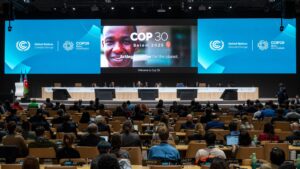 Disagreements continue as developed and developing countries struggle to agree on funding pathways to meet global climate targets.
Disagreements continue as developed and developing countries struggle to agree on funding pathways to meet global climate targets.
At COP29, countries failed to reach a breakthrough on climate finance for developing nations. The much-anticipated New Collective Quantified Goal (NCQG) fell short of expectations. Developed nations promised to raise climate funding from $100 billion annually to $300 billion by 2035 but this is far less than the estimated $1.3 trillion needed every year to help poorer nations fight climate change, adapt to its impacts, and reduce emissions.
As part of the NCQG deal, the Baku to Belém Roadmap was launched by the COP29 and COP30 Presidencies. Its purpose is to figure out how to raise the $1.3 trillion required annually by 2035 to support developing countries’ climate efforts — from cutting emissions to adapting to floods, droughts, and storms. A summary of progress will be presented at COP30.
But submissions made by countries so far reveal deep differences.
Global South Wants Grants; Global North Pushes Private Sector
Developing countries, such as those in the G77 and China bloc, the Least Developed Countries (LDC), and the Like-Minded Developing Countries (LMDC) group (which includes India), are demanding that climate finance come mainly through public money — grants and cheap loans — to support their self-decided climate plans. They are pushing for predictable, concessional, and non-debt-creating funds that won’t strain their fragile economies.
These nations insist that finance must respect their sovereignty. For example, LMDC warned against international taxes or debt swaps that could damage their economies. Small island states and the LDC bloc are also asking for a fair share of funds, especially as they face rising sea levels and extreme weather.
On the other hand, developed countries like the EU, Japan, the UK, Canada, and Norway prefer using private-sector investments and voluntary contributions. They argue that large-scale finance can only be mobilised by unlocking private capital and creating investment-friendly environments. The EU wants to use carbon pricing and reform fossil fuel subsidies; Norway supports carbon credit trading.
Key Concerns: Access to Funds, Barriers, and Instruments
Developing nations raised concern over systemic barriers that stop them from getting easy, affordable finance. India, G77, and China stress that finance should exclude costly market loans. These nations also called for more money for adaptation (like drought-resistant crops or flood defences) and compensation for loss and damage caused by climate change.
Small island nations demand simpler access to funds and reforms in the global financial system. They pointed to problems like biased credit ratings and high borrowing costs. The Arab Group raised similar issues, including foreign exchange risks and weak fiscal space.
Meanwhile, rich nations remain focused on “enabling environments” and tools like carbon markets, green bonds, and risk insurance — methods which many developing nations say shift responsibility away from rich countries.
Learning from Examples: Grants vs Markets
When asked for real-world models, developing countries suggested direct delivery examples — like Colombia’s “Heritage Colombia” (which protects forests) and Costa Rica’s payments for mangrove conservation. Small island states mentioned debt-for-climate swaps and regional finance systems.
Developed countries, however, pointed to market tools. The EU highlighted reports from the Coalition of Finance Ministers for Climate Action and funds from development banks. Norway promoted a carbon credit trading system, while Canada backed risk-sharing instruments.
India’s Stand: Finance First, Action Later
India stressed that climate ambition depends on proper funding. Without reliable finance, countries like India cannot increase their climate commitments. India called for country-driven, public-funded approaches, a balance between adaptation and mitigation finance, and affordable access to clean technologies.
It warned that developing nations cannot carry climate costs alone — public finance must remain central, with private finance playing only a supporting role.
The Road Ahead: Can the Divide Be Bridged?
The Baku to Belém Roadmap has made one thing clear: the world remains split on climate finance. The Global South wants rich countries to provide public money. The Global North prefers to shift responsibility to private markets.
Whether the COP Presidencies can bridge this divide and lay out a clear, fair, and workable finance plan by COP30 remains uncertain but the success of global climate action may depend on it.
